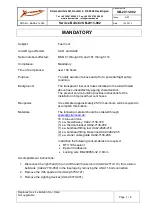
8
The TAKOO 3 lands excellently, it transforms the wing speed into lift on
the pilot’s demand, allowing an enormous margin of error. You will not
have to wrap the brake lines around your hand to get greater braking
efficiency.
The TAKOO 3 absorbs the speed in order to allow you a perfect landing,
even on days with nil wind.
4. IN FLIGHT
4.1 FLYING IN TURBULENCE
The TAKOO 3 complies with an excellent certification to face this type of
situation with the best safety guarantee. This wing is stable in all types
of weather conditions. It reacts admirably in passive flight, thus offering
a high level of safety in turbulent conditions. Nonetheless, all gliders
always have to be piloted according to the prevailing weather conditions;
the pilot is the ultimate safety factor.
We recommend that the pilot adopts a proactive attitude when flying,
making the necessary fine adjustments to keep the wing in control. He
should avoid the glider to collapse, by acting correctly to increase the
speed of his glider. He/she should stop braking to allow it to fly at the
required wing speed after a correction is made.
Do not maintain any correction for longer than necessary (braked) this
would cause the wing to enter into critical flying situation. Whenever
necessary, control a situation, react to it and then re-establish the
required speed.
4.2 POSSIBLE CONFIGURATIONS
We recommend that training to master these manoeuvres be carried out
under the supervision of a competent school. The pilot should always act
on the brakes depending on the load/m² of the moment, avoiding over-
handling with a small load or a lack of energy with a high load.
On the flight test report there is all necessary information to know how
the new glider will react on each manoeuvres tested.
It is important to take into account that each size can have a different
reaction on the same manoeuvres. Furthermore, the same size on
maximum load o minimum load can experiment a different behaviour.
Only knowing that we will be able to forecast how our glider will react
during these manoeuvres when flying and how we have to act to in each
situation.
Our recommendation is these manoeuvres are to be taught under the
control of a flight school within a S.I.V course.
Asymmetric collapse
In spite of the great stability of the profile of the TAKOO 3, heavy
turbulent conditions may cause part of the wing to collapse
asymmetrically. This usually happens when the pilot has not foreseen this
possible reaction of the wing. When the wing is about to experience an
asymmetric collapse the brake lines and the harness will transmit a loss
of pressure to the pilot. To prevent the collapse from happening, pull the
brake line corresponding to the compromised side of the wing, this will
increase the angle of incidence. If the collapse does happen the TAKOO
3 will not react violently, the turn tendency is very gradual and it is easily
controlled. Lean your body towards the side that is still flying in order
to counteract the turn and to maintain a straight course, if necessary
slightly slow down the same side. The collapse will normally open by
itself but if that does not happen, pull completely on the brake line on
the side, which has collapsed (100%). Do this with a firm movement. You
may have to repeat this operation to provoke the re-opening. Take care
not to over-brake on the side that is still flying (turn control) and when
the collapse has been solved; remember to let the wing recover its flying
speed.
Summary of Contents for TAKOO 3
Page 1: ...USER S MANUAL TAKOO 3...
Page 17: ...16 11 3 RISER ARRANGEMENT TAKOO 3...
Page 18: ...17 11 4 LINE PLAN TAKOO 3...







































